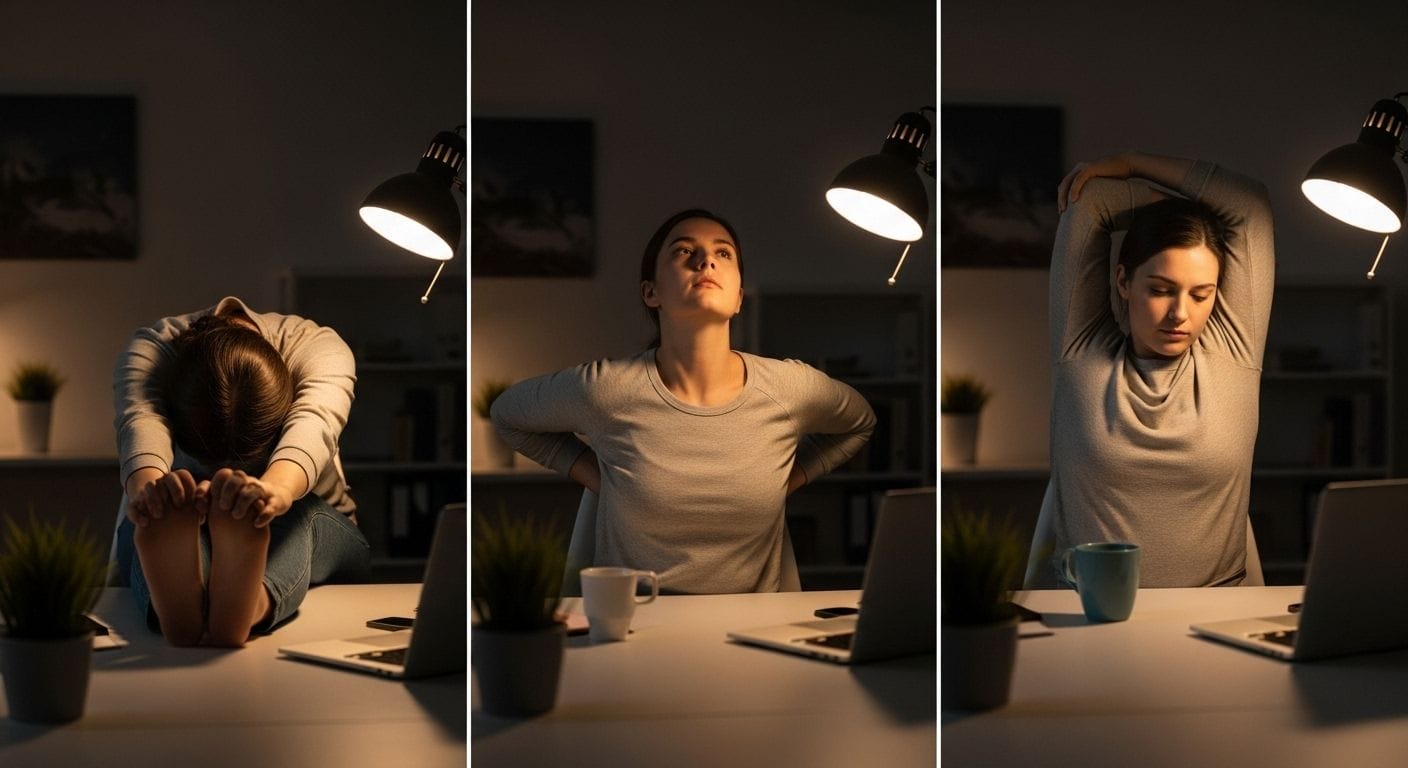6 Two-Minute Stretches to Undo a Day at the Desk
BY JENNIFER KIM • PUBLISHED NOVEMBER 26, 2025 • 5 MIN READ

QUICK TAKE
Sitting for eight hours creates tension in your neck, shoulders, and lower back. These six stretches target the most common problem areas and take less than two minutes each. University Health Network physiotherapists recommend five minutes of stretching for every hour of desk work.
Research shows that people who sit more than 75% of the day have an increased risk for neck and back pain. The ideal ratio for desk work is 20 minutes sitting, 8 minutes standing, and 2 minutes moving every 30 minutes. That's not always realistic. These stretches help when you can't move as much as you should.
📚 Source
Cleveland Clinic (2022); Sport & Spinal Physiotherapy (2022); Center for Spine & Orthopedics (2024)
1. Neck Side Stretch
Most people hold tension in the upper trapezius—the muscle that runs from your neck to your shoulder. This stretch releases that tightness.
How to do it:
Sit up straight. Drop your right ear toward your right shoulder. For a deeper stretch, place your right hand gently on the left side of your head and apply light pressure. Hold for 20-30 seconds. Switch sides. Repeat 2-3 times per side.
You should feel a stretch along the side of your neck and shoulder. Stop if you feel pain.
📚 Source
Canadian Centre for Occupational Health and Safety; UHN Foundation (2025)
2. Shoulder Shrugs and Rolls
Hunching your shoulders while typing creates tension in the trapezius and surrounding muscles. This exercise gets blood flowing and releases built-up stress.
How to do it:
Sit or stand with your back straight. Lift both shoulders toward your ears. Hold for 3-5 seconds, then drop them down. Repeat 8-10 times. Follow with shoulder rolls—roll your shoulders backward in a circular motion 5 times, then forward 5 times.
📚 Source
Paste Magazine (2023); Xtalks (2025)
3. Chest Opener
Sitting at a keyboard pulls your shoulders forward and compresses your chest. This stretch reverses that position and opens up your breathing.
How to do it:
Sit at the edge of your chair. Clasp your hands behind your back (or behind the chair back). Straighten your elbows, roll your shoulders back, and squeeze your shoulder blades together. Push your chest forward. Hold for 20-30 seconds. Repeat 3-5 times.
📚 Source
UHN Foundation (2025); Optimal Sports PT (2021)
4. Seated Spinal Twist
Lower back stiffness comes from staying in one position too long. This gentle twist increases mobility in your spine and releases tension.
How to do it:
Sit with your feet flat on the floor. Cross your right leg over your left. Twist your torso to the right, placing your left hand on your right knee and your right hand on the chair back or armrest. Hold for 20-30 seconds. Return to center and repeat on the other side. Do 2-3 times per side.
📚 Source
Readers.com (2024); WebMD
5. Hip Flexor Stretch
Hip flexors tighten when you sit for long periods. Tight hip flexors contribute to lower back pain and poor posture.
How to do it:
Sit at the edge of your chair. Bring your right ankle to rest on your left knee. Gently push your right knee toward the floor. For a deeper stretch, keep your back straight and lean forward slightly. Hold for 20-30 seconds. Switch sides. Repeat 2-3 times per side.
📚 Source
UHN Foundation (2025); Sport & Spinal Physiotherapy (2022)
6. Upper Back Stretch
Your upper back (thoracic spine) gets compressed from hunching forward. This stretch creates space between your shoulder blades.
How to do it:
Sit up straight. Interlace your fingers and extend your arms in front of you, palms facing away. Round your upper back and reach forward, letting your shoulder blades spread apart. Hold for 15-20 seconds. For variation, you can also raise your clasped hands overhead, palms facing the ceiling, and gently push upward. Repeat 3-5 times.
📚 Source
Canadian Centre for Occupational Health and Safety; Readers.com (2024)
Set a timer on your phone for every hour. When it goes off, pick 2-3 of these stretches and do them. You don't need to do all six every time—rotating through them throughout the day is enough.
Better yet, use a small water glass instead of a large bottle. You'll have to get up to refill it more often, which forces you to move. Small habits add up.
